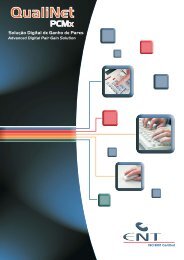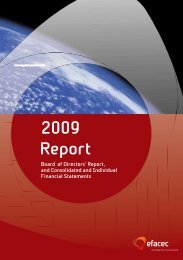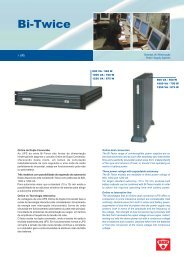Notes to the consolidated financial statements - Efacec
Notes to the consolidated financial statements - Efacec
Notes to the consolidated financial statements - Efacec
Create successful ePaper yourself
Turn your PDF publications into a flip-book with our unique Google optimized e-Paper software.
1.11 Accounts receivable from cus<strong>to</strong>mers and o<strong>the</strong>r deb<strong>to</strong>rs<br />
Accounts receivable from cus<strong>to</strong>mers and o<strong>the</strong>r deb<strong>to</strong>rs are initially recognised at <strong>the</strong>ir nominal or fair value, when different, less<br />
any impairment loss. The provision for receivable accounts impairment is set up when <strong>the</strong>re is objective evidence that <strong>the</strong> Group<br />
will not receive <strong>the</strong> entire amount outstanding, as per <strong>the</strong> original conditions established for <strong>the</strong> debt. The amount of <strong>the</strong> provision<br />
is <strong>the</strong> difference between <strong>the</strong> amount presented and <strong>the</strong> estimated present value of future cash fl ows, discounted at <strong>the</strong> effective<br />
interest rate. The amount of <strong>the</strong> provision is recognised in <strong>the</strong> profi t and loss account.<br />
1.12 Cash and cash equivalents<br />
The line “Cash and cash equivalents” includes cash, bank deposits, o<strong>the</strong>r short-term high liquidity investments and with initial<br />
maturities up <strong>to</strong> three months. Bank overdrafts are shown in <strong>the</strong> Balance Sheet under current liabilities in <strong>the</strong> line Loans.<br />
1.13 Share capital<br />
Ordinary shares are shown in shareholders’ funds.<br />
The incremental costs directly attributable <strong>to</strong> <strong>the</strong> issue of new shares or options are shown in shareholders’ funds as a reduction,<br />
net of taxes, of increases in share capital. The incremental costs directly attributable <strong>to</strong> <strong>the</strong> issue of new shares or options or <strong>the</strong><br />
acquisition of a new business are included in <strong>the</strong> cost of acquisition as part of <strong>the</strong> purchase price.<br />
1.14 Loans obtained<br />
Loans are initially recognised at <strong>the</strong>ir nominal value or fair value, whenever different, less any impairment loss. Later <strong>the</strong>y are<br />
shown at <strong>the</strong>ir amortised cost; any difference between receipts (net of transaction costs) and <strong>the</strong> amortised value is recognised in<br />
<strong>the</strong> profi t and loss account throughout <strong>the</strong> loan period, using <strong>the</strong> effective rate method.<br />
Loans are shown in current liabilities, unless <strong>the</strong> Group has an unconditional right <strong>to</strong> defer payment of <strong>the</strong> liability until at least 12<br />
months after <strong>the</strong> balance sheet date.<br />
1.15 Income tax and deferred taxes<br />
EFACEC Capital, S.G.P.S. opted for taxation based on <strong>consolidated</strong> profi ts as from 1993, currently covered by <strong>the</strong> “Special Rules<br />
for Taxation of Groups of Companies”. All Group companies whose headquarters are located in Portugal and are subject <strong>to</strong> <strong>the</strong><br />
Portuguese Corporate Income Tax (IRC), and where <strong>the</strong> direct and indirect share holding is greater than 90%, have been included<br />
in <strong>the</strong> tax consolidation in accordance with <strong>the</strong> applicable legislation. The <strong>consolidated</strong> tax charge is determined on <strong>the</strong> basis of <strong>the</strong><br />
arithmetic sum of taxable profi ts and losses as derived from individual companies’ tax returns.<br />
Deferred taxes are generally recognised using <strong>the</strong> liability method concerning temporary differences arising from <strong>the</strong> tax base<br />
of assets and liabilities and <strong>the</strong>ir respective values in <strong>the</strong> <strong>consolidated</strong> fi nancial <strong>statements</strong>. However, if <strong>the</strong> deferred tax arises<br />
through <strong>the</strong> initial recognition of an asset or liability in a transaction that is not a business concentration that at <strong>the</strong> date of <strong>the</strong><br />
transaction did not affect ei<strong>the</strong>r <strong>the</strong> accounting or fi scal result, it is not booked. Deferred taxes are determined by fi scal taxes (and<br />
laws) in force or substantially in force at <strong>the</strong> balance sheet date and which are expected <strong>to</strong> be applicable in <strong>the</strong> period when <strong>the</strong><br />
deferred tax asset or <strong>the</strong> payment of <strong>the</strong> deferred tax liability takes place. The tax rate that has been used <strong>to</strong> determine deferred<br />
taxes is that in force according <strong>to</strong> current legislation – 26.5% including local municipal tax.<br />
Deferred tax assets are recognised <strong>to</strong> <strong>the</strong> extent that it is probable that future taxable profi ts will be available <strong>to</strong> make use of <strong>the</strong><br />
timing difference.<br />
Deferred taxes on timing differences arising from investments in affi liates and associates are recognised, except when <strong>the</strong> Group<br />
is able <strong>to</strong> control <strong>the</strong> haphazard nature of <strong>the</strong> reversal of <strong>the</strong> timing difference and when it is probable that <strong>the</strong> timing difference<br />
does not revert in <strong>the</strong> foreseeable future.<br />
Deferred taxes are classifi ed as Current or Non-Current, according <strong>to</strong> <strong>the</strong> presentation of <strong>the</strong> amounts in <strong>the</strong> balance sheet <strong>to</strong> which<br />
<strong>the</strong>y relate, or <strong>to</strong> whe<strong>the</strong>r <strong>the</strong> respective timing differences are reverted in <strong>the</strong> short or medium/long-term.<br />
1.16 Provisions<br />
Provisions are booked when <strong>the</strong> Group has a legal or constructive obligation and that, as a result of past events, it is probable<br />
that an outfl ow of resources will be necessary <strong>to</strong> pay an obligation, and a reliable estimate of <strong>the</strong> amount of <strong>the</strong> obligation can be<br />
made.<br />
When <strong>the</strong>re is a number of similar obligations, <strong>the</strong> probability of generating an outfl ow is worked out <strong>to</strong>ge<strong>the</strong>r. The provision is<br />
booked even when <strong>the</strong> probability of an outfl ow, relating <strong>to</strong> an element included in <strong>the</strong> same class of obligations, may be reduced.<br />
14

















